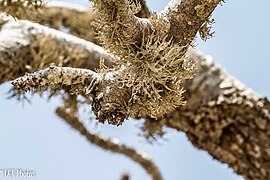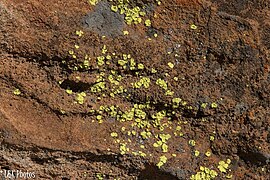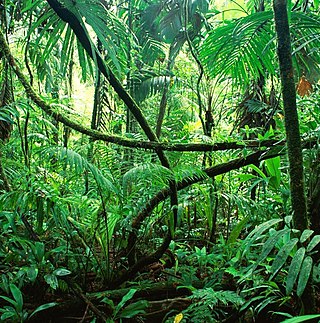
Rainforests are forests characterized by a closed and continuous tree canopy, moisture-dependent vegetation, the presence of epiphytes and lianas and the absence of wildfire. Rainforests can be generally classified as tropical rainforests or temperate rainforests, but other types have been described.

A lichen is a composite organism that arises from algae or cyanobacteria living among filaments of multiple fungi species in a mutualistic relationship. Lichens are important actors in nutrient cycling and act as producers which many higher trophic feeders feed on, such as reindeer, gastropods, nematodes, mites, and springtails. Lichens have properties different from those of their component organisms. They come in many colors, sizes, and forms and are sometimes plant-like, but are not plants. They may have tiny, leafless branches (fruticose); flat leaf-like structures (foliose); grow crust-like, adhering tightly to a surface (substrate) like a thick coat of paint (crustose); have a powder-like appearance (leprose); or other growth forms.
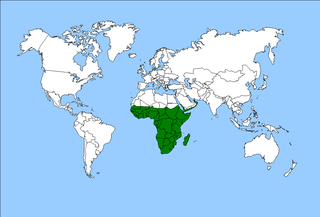
The Afrotropical realm is one of the Earth's eight biogeographic realms. It includes Sub-Saharan Africa, the southern Arabian Peninsula, the island of Madagascar, and the islands of the western Indian Ocean. It was formerly known as the Ethiopian Zone or Ethiopian Region.

Pioneer species are resilient species that are the first to colonize barren environments, or to repopulate previously biodiverse steady-state ecosystems that have been disrupted by natural disasters such wildfire, flood, mudslide, lava flow or a climate-related extinction event or by anthropogenic habitat destruction.

The Madagascar subhumid forests are a tropical moist broadleaf forest ecoregion that covers most of the Central Highlands of the island of Madagascar. They are included in the WWF's Global 200 list of outstanding ecoregions. Most of the original habitats have been lost due to human pressure.

The Madagascar dry deciduous forests represent a tropical dry forest ecoregion situated in the western and northern part of Madagascar. The area has high numbers of endemic plant and animal species but has suffered large-scale clearance for agriculture. They are among the world's richest and most distinctive dry forests and included in the Global 200 ecoregions by the World Wide Fund. The area is also home to distinctive limestone karst formations known as tsingy, including the World Heritage Site of Bemaraha.

Isalo National Park is a National Park in the Ihorombe Region of Madagascar, in the southwestern corner of the Province of Fianarantsoa. The closest town is Ranohira, and the closest cities are Toliara and Ihosy. It is a sandstone landscape that has been dissected by wind and water erosion into rocky outcrops, plateaus, extensive plains and up to 200 m (660 ft) deep canyons. There are permanent rivers and streams as well as many seasonal watercourses. Elevation varies between 510 and 1,268 m.
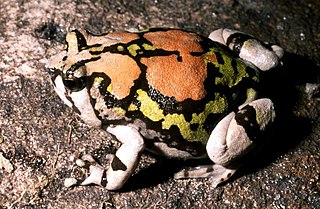
Scaphiophryne gottlebei, commonly known as the Malagasy rainbow frog, ornate hopper, rainbow burrowing frog, red rain frog or Gottlebe's narrow-mouthed frog, is one of the most highly decorated frogs from Madagascar. The primary threats to this endangered species are habitat loss and capture for the pet trade.

The Malagasy brush warbler, also known as the Madagascar brush-warbler, is a species of Old World warbler in the family Acrocephalidae. It is found in Comoros and Madagascar. Its natural habitats are subtropical or tropical dry forests, subtropical or tropical moist lowland forests, and subtropical or tropical moist shrubland.
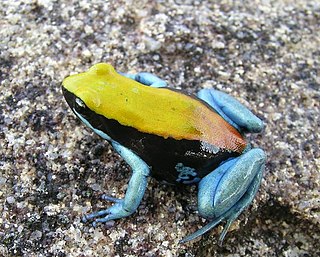
The blue-legged mantella is a small species of frog in the family Mantellidae. It is endemic to the Isalo National Park and areas south of it in Madagascar, a range it shares with the rainbow frog. Both are locally common, but endangered due to habitat loss and over-collected for the pet trade.
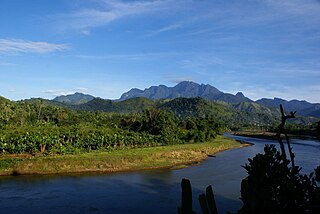
Marojejy National Park is a national park in the Sava region of northeastern Madagascar. It covers 55,500 ha (214 sq mi) and is centered on the Marojejy Massif, a mountain chain that rises to an elevation of 2,132 m (6,995 ft). Access to the area around the massif was restricted to research scientists when the site was set aside as a strict nature reserve in 1952. In 1998, it was opened to the public when it was converted into a national park. It became part of the World Heritage Site known as the Rainforests of the Atsinanana in 2007. "Unique in the world, a place of dense, jungly rainforests, sheer high cliffs, and plants and animals found nowhere else on earth", Marojejy National Park has received plaudits in the New York Times and Smithsonian Magazine for its natural beauty and rich biodiversity that encompasses critically endangered members of the silky sifaka. To that end, a global consortium of conservation organizations, including the Lemur Conservation Foundation, Duke Lemur Center and Madagascar National Parks, have sought to promote research and conservation programs in Marojejy National Park, neighboring Anjanaharibe-Sud Reserve and Antanetiambo Private Reserve, to protect the endemic flora and fauna that reside in northeastern Madagascar. In addition, these organizations have implemented a variety of community-based initiatives to mitigate human encroachment on the park, such as poaching and selective logging, by encouraging local communities to engage in afforestation and silvicultural initiatives to promote a sustainable alternative to mining, slash-and-burn agriculture, and wood collection.

Tsimanampetsotsa National Park also spelt Tsimanampetsotse, and known as Tsimanampetsotsa Nature Reserve is a 432 km2 national park on the south-west coast of Madagascar in the region Atsimo-Andrefana. The park is 90 kilometres (56 mi) south of Toliara and 950 kilometres (590 mi) south of the capital, Antananarivo. Route Nationales (RN) 10 to Faux Cap passes the park and the nearest airport is at Toliara. The national park contains and is named after Lake Tsimanampetsotsa.

Zombitse-Vohibasia is a national park in the Atsimo-Andrefana region of south-west Madagascar. It is 147 kilometres (91 mi) north-east of the town of Toliara on the National road 7.

The Arthoniales is the second largest order of mainly crustose lichens, but fruticose lichens are present as well. The order contains around 1500 species, while the largest order with lichenized fungi, the Lecanorales, contains more than 14000 species.
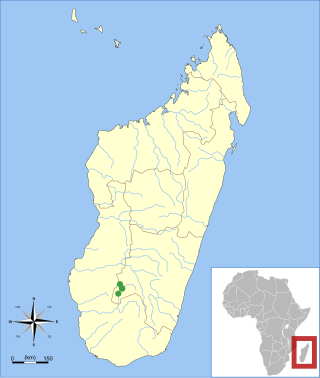
The Isalo serotine is a vesper bat of Madagascar in the genus Laephotis. It is known only from the vicinity of the Isalo National Park in the southwestern part of the island, where it has been caught in riverine habitats. After the first specimen was caught in 1967, it was described as a subspecies of Eptesicus somalicus in 1995. After four more specimens were collected in 2002 and 2003, it was recognized as a separate species. Because of its small distribution and the threat of habitat destruction, it is considered "vulnerable" in the IUCN Red List.

Montane ecosystems are found on the slopes of mountains. The alpine climate in these regions strongly affects the ecosystem because temperatures fall as elevation increases, causing the ecosystem to stratify. This stratification is a crucial factor in shaping plant community, biodiversity, metabolic processes and ecosystem dynamics for montane ecosystems. Dense montane forests are common at moderate elevations, due to moderate temperatures and high rainfall. At higher elevations, the climate is harsher, with lower temperatures and higher winds, preventing the growth of trees and causing the plant community to transition to montane grasslands and shrublands or alpine tundra. Due to the unique climate conditions of montane ecosystems, they contain increased numbers of endemic species. Montane ecosystems also exhibit variation in ecosystem services, which include carbon storage and water supply.

The flora of Madagascar consists of more than 12,000 species of plants, as well as a poorly known number of fungi and algae. Around 83% of Madagascar's vascular plants are found only on the island. These endemics include five plant families, 85% of the over 900 orchid species, around 200 species of palms, and such emblematic species as the traveller's tree, six species of baobab and the Madagascar periwinkle. The high degree of endemism is due to Madagascar's long isolation following its separation from the African and Indian landmasses in the Mesozoic, 150–160 and 84–91 million years ago, respectively. However, few plant lineages remain from the ancient Gondwanan flora; most extant plant groups immigrated via across-ocean dispersal well after continental break-up.

Oplurus quadrimaculatus, the Duméril's Madagascar Swift or Madagascar spotted spiny-tailed iguana, is a terrestrial malagasy iguana belonging to the family Opluridae.

Cladonia arbuscula, also referred to as shrubby cup lichen or green reindeer lichen, is a species of cup lichen in the family Cladoniaceae.
Isalonactis is a monotypic fungal genus in the family Roccellaceae. It contains the single species Isalonactis madagascariensis, a saxicolous (rock-dwelling), crustose lichen found in Madagascar. Both the genus and species were described as new in 2014 by Damien Ertz, Anders Tehler, Eberhard Fischer, Dorothee Killmann, Tahina Razafindrahaja, and Emmanuël Sérusiaux. The type was collected on the Isalo Massif at an altitude of 851 m (2,792 ft); there, it was found growing on sheltered mesozoic sandstone cliffs. The genus name alludes to both Isalo Massif, the type locality, and the phylogenetic relatedness to genus Lecanactis.
